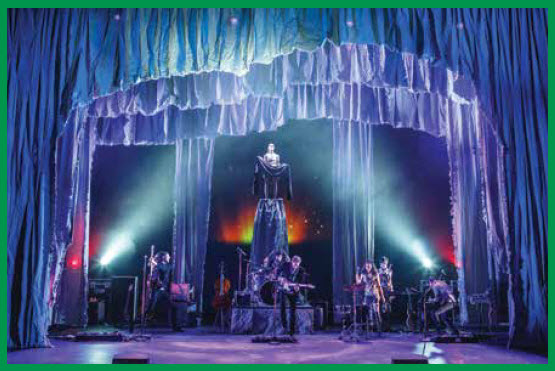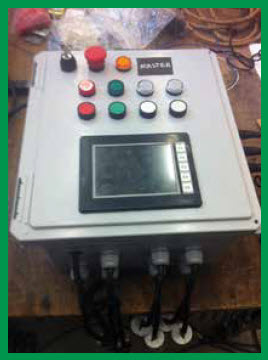From Wikipedia[1]: “A mechane (pron.: /’mɛkəniː/; Greek: μηχανή, mēkhanē) or machine was a crane used in Greek theatre, especially in the 5th and 4th centuries BC. Made of wooden beams and pulley systems, the device was used to lift an actor into the air, usually representing flight. This stage machine was particularly used to bring gods onto the stage from above, hence the Latin term deus ex machina (“god out of the machine”). Euripides’ use of the mechane in Medea (431 BC) is a notable use of the machine for a non-divine character. It was also often used by Aeschylus. It was used to allow actors playing gods to fly through the air.
Creating a Stage Machine
 Stage machines were also used in ancient Rome, e.g. during the sometimes highly dramatic performances at funerals. For Julius Caesar’s funeral service, Appian reports a mechane that was used to present a blood-stained wax effigy of the deceased dictator to the funeral crowd. The mechane was used to turn the body in all directions.” (wiki image)
Stage machines were also used in ancient Rome, e.g. during the sometimes highly dramatic performances at funerals. For Julius Caesar’s funeral service, Appian reports a mechane that was used to present a blood-stained wax effigy of the deceased dictator to the funeral crowd. The mechane was used to turn the body in all directions.” (wiki image)
When the Department of Theatre at Purdue University decided to stage a production of Medea, Richard Dionne (the Technical Director) and his students knew they had a great opportunity for some “stage magic”. Mechanes and lifts of all types have been used to wow audiences for over 2500 years (albeit with varying degrees of safety). The Theater Dept. already owned a RibbonLift™ (a telescopic stage lift), but they knew it would take some shrewd engineering to make it safe enough to “fly” an actor on stage during a performance.
The department also owned a number of products from AutomationDirect such as the CLICK PLC lab stations that Rich uses every semester to teach his students how to automate all sorts of theater-related tasks. These stations are comprised of a fiberglass enclosure, a CLICK D0-02DD2-D PLC CPU, two 24VDC power supplies (one for field power, and the one for the PLC), a CLICK digital input module, a CLICK relay output module, four pushbuttons, four indicator lights, a 6” C-more Micro monochrome touchscreen display, and multiple cable tails for connecting field devices.

The students realized that given the available lift and one of the PLC lab stations, they would only need a few additional purchased parts, along with some welded parts and brackets, and they could produce a stable and safe lift platform which would also conform to the theater’s safety standards.
The project had to meet a number of specifications:
1. Have a stable platform into which an actor can be secured to prevent falling from height.
2. Include some feedback to prevent movement of lift when the actor was not secured.
3. Have a method for the actor to provide feedback that they feel safe to move.
4. Include a distributed emergency stop system that meets NFPA 70 codes for disconnecting power from automated systems, with emergency stop buttons located beside the operator on stage, an additional stage hand on the other side of the stage, and the stage manager in the booth.
5. Have a means for determining actual height of the unit.
6. Include a means for entering a desired height at which to stop travel (a soft limit)—and, if possible, to enter multiple soft limits.
7. Include hard limits at extreme up and down travel, independent of software limits.
8. Have a means of controlling velocity in both the up and down direction of travel.
9. Provide a means of remotely signaling the stage manager that the actor is secure, the actor is ready to move, that the lift is moving, and that an emergency stop has not been triggered.
Designing the Stage Machine
Students designed a welded-steel base into which an actor could be belted using an after-market automobile seat belt; this base comprised a steel tube upright with a U-shaped bracket to wrap around the waist of the actor, to which the seat belt was attached. Weld-nuts at consistent spacing were used along the length of the steel tube column to allow for height adjustment. The seat belt was wired with a normally-open contact which closed whenever the seat belt was latched.
With the CLICK PLC lab station as a starting point, students in the class designed a control system that included:
– A normally-open contact sensor from the seatbelt
-A momentary-contact deadman switch for the actor, to be mounted on the post at the small of the back
– A normally-open limit switch with a roller-level arm for the upper limit and a normally-open limit switch with a rocker-arm for the lower limit
-A normally-open capacitive sensor placed as a position counter along the travel of the ribbon mast
The motor which drives the RibbonLift is driven by an amplifier which normally receives DC voltages between -10 and +10 to control velocity and direction of travel; because the CLICK CPU analog output controls only vary DC voltage between 0 and 5 volts, students decided to build two op-amp circuits that varied -10VDC to 0VDC for down travel and 0VDC and +10VDC for up travel based on two separate outputs of 0VDC to 5VDC.
For the emergency-stop system, the students felt it problematic to route 208VAC cable all over the theatre to allow for direct disconnection of power. Rather, they designed a system which controlled a 208VAC relay using distributed 24VDC power. By routing 24VDC through each normally-closed mushroom emergency stop button in series with the relay coils, they felt that they would be able to ensure that hitting an emergency stop button anywhere in the system would immediately cause the relay to cut off the 208VAC power supply to the motor. Additionally, the students decided to use this same 24VDC circuit to provide feedback to the PLC that an emergency stop button was tripped, ensuring that the PLC would stop sending movement commands to the unit (so that when power was restored, it didn’t begin moving immediately).
The students opted to utilize an RS485 serial connection between the PLC controlling the unit and a remote PLC in the control booth to provide real-time feedback to the stage manager about the status of the effect, using both indicator lights and the touchscreen display, providing the stage manager with a mirror image of the operator’s console.
Rich reports that the lift worked perfectly “The actress playing Medea, who was on the lift, said, ‘I felt more safe than on a real elevator.’”, and he went on to mention that the project also met all the cost constraints: “Given that the department already owned the RibbonLift, the PLC controls, and multiple limit and proximity switches, our set-up costs were minimal: less than $250 to purchase some additional switches, connectors, cables, and enclosures. All the control devices were obtained from AutomationDirect.”
After a successful run of Medea on campus in February, the students were honored to be asked to present their design at the annual USITT technical theatre conference in March in Milwaukee, Wisconsin. The lift was crated and shipped to Milwaukee for the show, where it became an instant hit, with attendees lined up and down the aisle for a chance to “ride” it and get a bird’s eye view of the show hall.
The students that worked on the lift project included: Michael Banks, Sean Cole, Steve Hnath, Jeremy Jenkins, Derek Miller, Ash Owens, and Addison Snyder.
Richard Dionne is the Production Manager and Technical Director for the Department of Theatre, Patti and Rusty Rueff School of Visual and Performing Arts at Purdue University where he also teaches classes in theater automation.
The Purdue University Department of Theatre offers a full complement of undergraduate and graduate degrees, emphasizing the collaborative spirit of theatre and a strong partnership between art and technology. The department is proud of its national and international connections and the success of its alumni. Purdue Theatre has the distinction of a dual mission; it serves a wide-ranging group of students, while also serving Purdue University and the Greater Lafayette area as a primary cultural resource for the community.
For more information about the Purdue Department of Theatre please visit: http://www.cla.purdue.edu/theatre/
By Chip McDaniel,
AutomationDirect
1. Mechane. (2013, March 7). In Wikipedia, The Free Encyclopedia. Retrieved 12:54, April 17, 2013, from: http://en.wikipedia.org/w/index.php?title=Mechane&oldid=542513923
2. Additional credits for this production: Medea, by Euripedes, Translated by Ian Johnston, Directed by Michael Lenz, Music by Ian Sturges Milliken, Set Design by Derek Miller, Lighting Design by Michael
Banks and Greg Freeman, Costume Design by Jill Van Brussel
Disclaimer: AutomationDirect does not guarantee the products described in this article are suitable for your particular application, nor do we assume any responsibility for your product/system design, installation, or operation.
Originally Posted: Sept. 9, 2013



